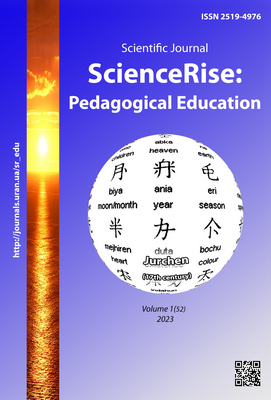Visualization of distance learning
DOI:
https://doi.org/10.15587/2519-4984.2023.275389Keywords:
distance learning, teaching staff, postgraduate education, visualization of distance learning, digital toolsAbstract
The article is devoted to highlighting the current problems of creating visual support for distance learning of pedagogical workers in the conditions of postgraduate education. The current experience in training teachers to create a visualization of distance learning of teachers in postgraduate education is considered. Attention is paid to the modern problems of distance learning, the experience of organizing advanced training courses, implementation of thematic, author's courses for teachers of general secondary education institutions and vocational pre-higher education institutions is described. A description of the content of the training of teachers on the author's remote professional development courses is provided. A description of the preparation of a visual series for remote training of teachers in the postgraduate education system is given. Features of the use of modern digital tools and technology for creating electronic materials for the organization of distance learning are considered. A description of the use of video conferencing systems in distance learning is provided, examples of creating video materials for conducting distance classes are described. The experience of organizing distance classes is described and a description of the types of classes in distance learning is provided.
The list of problems of the pedagogical community in the process of organizing distance learning in crisis conditions is presented. The problems and needs of professional improvement of teachers, which can be solved during the period of professional development in the system of postgraduate education, are singled out.
The results of research in the post-graduate education system are described, which demonstrate the solution to the problems of distance learning visualization based on the author's professional development courses. The meaningful content of distance, network, electronic training of teachers, the selection of effective technologies for the preparation of visual support for conducting classes in a distance format are recognized
References
- Liakhotskoi, L. L. (Ed.) (2017). Orhanizatsiia osvitnoho protsesu v zakladakh pisliadyplomnoi pedahohichnoi osvity z vykorystanniam elektronnykh tekhnolohii navchannia. Kyiv, 198.
- Zhaldak, M. I., Lapinskyi, V. V., Shut, M. I. (2004). Komp’iuterno-oriientovani zasoby navchannia matematyky, fizyky, informatyky. Kyiv: Dinit, 182.
- Hrytsenko, V. I. (2005). Suspilstvo v informatsiinu epokhu: realii i perspektyvy rozvytku. Visnyk NAN Ukrainy, 6, 28–32.
- Perraton, H.; Sewart, D., Keegan, D., Holmberg, B. (Eds.) (1988). A theory for distance education. Distance education: International perspectives. New York: Routledge, 34–45.
- Plummer, D. C., Cearley, D. W., Smith, D. M. (2008). Cloud Computing Confusion Leads to Opportunity. Report No. G00159034. – Gartner Group. Available at: http://www.gartner.com/it/content/868800/868812/cloud_computing_confusion.pdf
- Quendler, E., Lamb, M. (2016). Learning as a lifelong process – meeting the challenges of the changing employability landscape: competences, skills and knowledge for sustainable development. International Journal of Continuing Engineering Education and Life-Long Learning, 26 (3), 273–293. doi: https://doi.org/10.1504/ijceell.2016.078447
- Boyd, G.; Keegan, D. (Ed.) (1993). A theory of distance education for the cyberspace era. Theoretical principles of distance education. London: Routledge, 234–253.
- Pro zatverdzhennia Polozhennia pro dystantsiine navchannia (2013). Nakaz MON Ukrainy № 466. 25.04.2013. Available at: https://osvita.ua/legislation/Dist_osv/2999/
- Bykova, V. Yu., Kukharenka, V. M. (Eds.) (2008). Tekhnolohiia stvorennia dystantsiinoho kursu. Kyiv: Milenium, 324.
- Bezuhlyi, D. S., Yurchenko, A. O., Udovychenko, O. M. (2018). Review of tools of computer visualization to support educational material. Science and Education a New Dimension, VI (153 (63)), 11–14. doi: https://doi.org/10.31174/send-pp2018-153vi63-02
- Bilousova, L. I., Zhytienova, N. V. (2016). Vizualizatsiia navchalnoho materialu z vykorystanniam tekhnolohii skraibinh u profesiinii diialnosti vchytelia. Fyzyko-matematycheskoe obrazovanye, 1 (7), 39–47.
- Kondratova, L. H. (2022). Organization of distance learning in conditions of maritime. The Russian-Ukrainian war (2014–2022): historical, political, cultural-educational, religious, economic, and legal aspects. Riga: Baltija Publishing, 734–740. doi: https://doi.org/10.30525/978-9934-26-223-4-88
- Silkova, O. V., Lobach, N. V. (2018). Pedahohichna tekhnolohiia vizualizatsii navchalnoi informatsii. Naukovyi chasopys NPU imeni M. P. Drahomanova, 62, 180–183.
- Semenikhina, O. V., Drushliak, M. H. (2016). Vizualizatsiia znan yak aktualnyi zapyt informatsiinoho suspilstva do sfery osvity. Innovatsiini tekhnolohii v protsesi pidhotovky fakhivtsiv. Vinnytsia, 156–160.
- Bilousova, L. I., Zhytienova, N. V. (2016). Vizualizatsiia navchalnoho materialu z vykorystanniam tekhnolohii skraibinh u profesiinii diialnosti vchytelia. Fyzyko-matematycheskoe obrazovanye, 1 (7), 39–47.
- Kondratova, L. H. (2019). Dystantsiinyi kurs «Metodyka vykladannia mystetstva v pochatkovii shkoli na zasadakh NUSh» yak zasib profesiinoho samorozvytku vchytelia mystetstva. Mystetstvo ta osvita, 3, 50–53.
Downloads
Published
How to Cite
Issue
Section
License
Copyright (c) 2023 Lyudmila Kondratova

This work is licensed under a Creative Commons Attribution 4.0 International License.
Our journal abides by the Creative Commons CC BY copyright rights and permissions for open access journals.
Authors, who are published in this journal, agree to the following conditions:
1. The authors reserve the right to authorship of the work and pass the first publication right of this work to the journal under the terms of a Creative Commons CC BY, which allows others to freely distribute the published research with the obligatory reference to the authors of the original work and the first publication of the work in this journal.
2. The authors have the right to conclude separate supplement agreements that relate to non-exclusive work distribution in the form in which it has been published by the journal (for example, to upload the work to the online storage of the journal or publish it as part of a monograph), provided that the reference to the first publication of the work in this journal is included.








